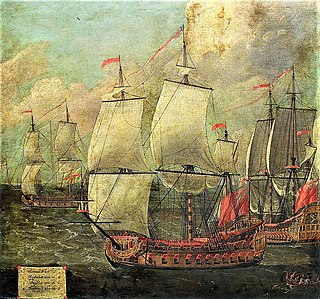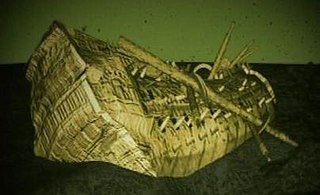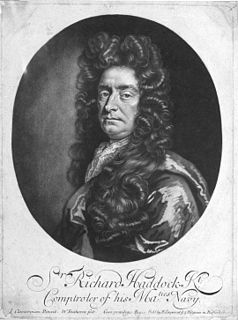Related Research Articles

Samuel Pepys was an English diarist and naval administrator. He served as administrator of the Navy of England and Member of Parliament and is most famous for the diary he kept for a decade while still a young man. Pepys had no maritime experience, but he rose to be the Chief Secretary to the Admiralty under both King Charles II and King James II through patronage, diligence, and his talent for administration. His influence and reforms at the Admiralty were important in the early professionalisation of the Royal Navy.

Charles Howard, 1st Earl of Carlisle was an English military leader and politician who sat in the House of Commons at various times between 1653 and 1660 and was created Earl of Carlisle in 1661.

Peter Pett, was an English Master Shipwright and Second Resident Commissioner of Chatham Dockyard. He protected of his scale models and drawings of the King's Fleet during the Dutch Raid on the Medway, in Kent in June 1667, during the Second Anglo-Dutch War.
The so-called Pett Dynasty was a family of shipwrights who prospered in England between the 15th and 17th centuries. It was once said of the family that they were "so knit together that the Devil himself could not discover them". This saying refers to the era during which Samuel Pepys was much involved in getting royal aid for Ann Pett, widow of Christopher Pett.The Petts Wood district of south-east London is named for the family.

Sir William Penn was an English admiral and politician who sat in the House of Commons from 1660 to 1670. He was the father of William Penn, founder of the Province of Pennsylvania.

Royal Charles was an 80-gun first-rate three-decker ship of the line of the English Navy. She was built by Peter Pett and launched at Woolwich Dockyard in 1655, for the navy of the Commonwealth of England. She was originally called Naseby, named in honour of Sir Thomas Fairfax's decisive 1645 victory over the Royalist forces during the English Civil Wars. She was ordered in 1654 as one of a programme of four second rates, intended to carry 60 guns each. However, she was altered during construction to mount a complete battery of guns along the upper deck, and so was reclassed as a first rate.

Edward Montagu, 1st Earl of Sandwich, KG PC FRS JP was an English military officer, politician and diplomat, who fought for the Parliamentarian army during the First English Civil War and was an MP at various times between 1645 and 1660. A loyal supporter of Oliver Cromwell, he was a member of the English Council of State from 1653 to 1659 and General at sea from 1656 to 1660. Following Cromwell's death in 1658, he switched allegiance and played an important role in the Restoration of Charles II in May 1660.
Sir William Batten was an English naval officer and politician, who sat in the House of Commons from 1661 to 1667. As Surveyor of the Navy, he was a colleague of Samuel Pepys, who disliked him and disparaged him several times in his famous Diary.

Sir Anthony Deane FRS (1633–1721) was a 17th-century mayor of Harwich, naval architect, Master Shipwright and commercial shipbuilder, and Member of Parliament.

Victory was a great ship of the English Navy, launched in 1620 and in active service during the seventeenth century's Anglo-Dutch Wars. After an seventy-year naval career, she was broken up at Woolwich Dockyard in 1691 and her timbers reused in other vessels.

HMS Assurance was a 32-gun fourth-rate frigate of the English Royal Navy, built by Peter Pett I at Deptford Dockyard and launched in 1646. The term 'frigate' during the period of this ship referred to a method of construction, rather than a role which did not develop until the following century.

London was a 76-gun second-rate ship of the line in the Navy of the Commonwealth of England, originally built at Chatham Dockyard by shipwright John Taylor, and launched in June 1656. She gained fame as one of the ships that escorted Charles II from Holland back to England during the English Restoration, carrying Charles' younger brother James Duke of York, and commanded by Captain John Lawson.

Harwich Dockyard was a Royal Navy Dockyard at Harwich in Essex, active in the 17th and early 18th century. Owing to its position on the East Coast of England, the yard was of strategic importance during the Anglo-Dutch Wars; however, due to a lack of deep-water access and the difficulty of setting off from Harwich against an easterly wind, its usefulness was somewhat limited and its facilities remained small-scale compared to the other Royal Dockyards over the same period. Nonetheless, it remained actively involved in repairing and refitting the nation's warships, as well as building them: of the eighty ships built for the Royal Navy in Britain between 1660 and 1688, fourteen were built at Harwich Dockyard..

Sir Richard Haddock was an officer of the Royal Navy. He served during the Anglo-Dutch Wars, eventually rising to the rank of Admiral in August 1690. In Herge's Adventures of Tintin, Richard Haddock was one of the inspirations for Captain Haddock's 17th century ancestor, Sir Francis Haddock.
Captain Roger Cuttance RN was a Royal Navy officer who took a prominent role in the Anglo-Dutch Wars.
Sir Martin Beckman (1634/35–1702) was a draughtsman/painter, Swedish-English colonel, chief engineer and master gunner of England.
Vice-Admiral Sir Richard Styner (1625–1662) was an English naval officer who supported the Parliamentary cause during the English Civil War and the Interregnum. During the First Anglo-Dutch War he commanded the Foresight in actions at Portland (February), and the Gabbard (June), and in the Battle of Scheveningen, 1653. During the Anglo-Spanish War (1654–1660), he won renown and a fortune in prize money when he captured a great part of the Spanish West Indian treasure fleet off Cadiz in 1656. He was knighted by the Lord Protector Oliver Cromwell for services in Admiral Robert Blake's destruction of Spanish ships at Santa Cruz, 1657. He was a rear-admiral of the fleet which brought Charles II to England in 1660. He was again knighted at the Restoration. He died at Lisbon, while serving as vice-admiral of the Mediterranean fleet.

Sir John Harman was an English naval officer who was captain and then admiral during the three Anglo-Dutch wars between 1652 and 1673. He fought in several major battles. He was captain of the flagship of the Duke of York, the future King James II of England, in the Battle of Lowestoft in 1665. The Dutch were defeated but escaped when Harman reduced sail due to a mistaken order. There was a great scandal over this incident, but Harman was completely absolved and was promoted to rear admiral. He played an epic role in the St. James's Day Battle in 1666. In 1667 he destroyed a French fleet off Martinique, then captured the French and Dutch colonies in South America. He died while still active as an admiral during the Third Anglo-Dutch War.
Sir Henry Johnson was an English shipbuilder and politician who sat in the House of Commons in 1679. He was one of the leading commercial shipbuilders on the River Thames during the period of enormous mercantile expansion and the Dutch wars after the Restoration..
References
- 1 2 Duke of York, James II (1729). Memoirs of the English Affairs, Chiefly Naval, from the Year 1660, to 1673. Google Books: Great Britain.
- ↑ "Dutch hired ship 'Rozeboom' (1652)".
- 1 2 3 Winfield, Rif (2009). British Warships in the Age of Sail 1603 -1714 - Fourth Rate. Seaforth Publishing. p. 102.
- 1 2 "The Diary of Samuel Pepys". 2 February 2019.
- ↑ "Pepys Diary - Thursday 31 July 1662".
- ↑ "Pepys Diary - Tuesday 16 December 1662".
- ↑ Matthews, William G. (1970). The Diary of Samuel Pepys, Vol. 1: 1660. University of California Press. p. 284.
- ↑ "Pepys Diary - Monday 27 April 1663".
- 1 2 Daniell, Francis Henry Blackburne (1863). Calendar of State Papers, Domestic Series, of the Reign of Charles ..., Volume 4. H.M. Stationery Office.
- ↑ Henning, Basil Duke (1983). The House of Commons, 1660-1690 II Members C-L. Secker & Warburg. p. 200.